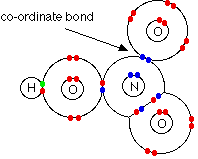Nitric acid (HNO3) is a clear, colorless liquid that is one of the strongest mineral acids.
In air, nitric acid (HNO3) fumes and turns yellow due to its decomposition into nitrogen
dioxide (NO2). Nitric acid is highly corrosive and a powerful oxidizing agent. It attacks most metals, resulting in the formation of nitrates.
With many organic compounds, nitration occurs. Melting point –42°C, boiling point 83°C.
Nitric acid is used in the production of fertilizers, explosives, plastics, dyes, and rocket propellants. It was called aqua fortis ("strong water") by the alchemists, a name
by which it continued to be known commercially.
How nitric acid is made
Nitric acid can be prepared in the lab by the distillation of a mixture
of an alkali-metal nitrate and concentrated
sulfuric
acid. Industrially, it is produced by the
Ostwald process (named after the Latvian-born German physical chemist Friedrich
Wilhelm Ostwald who developed it in 1902).
In this process,
ammonia is oxidized by
air to nitric oxide, at 900°C and 1–8 atmospheres using a
platinum or platinum-
rhodium catalyst in the form
of a thin wire gauze. The nitric oxide is further oxidized to nitrogen dioxide,
which is dissolved in water to give 60% nitric acid.
Use
of nitric acid in rocket engines
Nitric acid was commonly used as an oxidizer
in
liquid-propellant
rocket engines between 1940 and 1965. It most often took the form of
RFNA (red fuming nitric acid), containing 5–20% dissolved nitrogen
dioxide. Compared to concentrated nitric acid (also known as white fuming
nitric acid), RFNA is more energetic and more stable to store but produces
poisonous red-brown fumes. Because nitric acid is normally highly corrosive
it can only be stored and piped by a few materials such as stainless
steel. However, the addition of a small concentration of fluoride ions
inhibits the corrosive action and gives a form known as IRFNA (inhibited
red fuming nitric acid). Like
nitrogen
tetroxide, it is hypergolic (reacts upon contact with)
hydrazine,
MMH (monomethyl hydrazine), and
UDMH (unsymmetrical dimethyl hydrazine).
Medical effects of
nitric acid
Concentrated nitric acid is capable of producing severe burns of the skin.
Swallowing the acid leads to intense burning pain and ulceration of the
mouth and throat. Treatment is by immediate administration of alkaline solutions,
followed by milk or olive oil.



